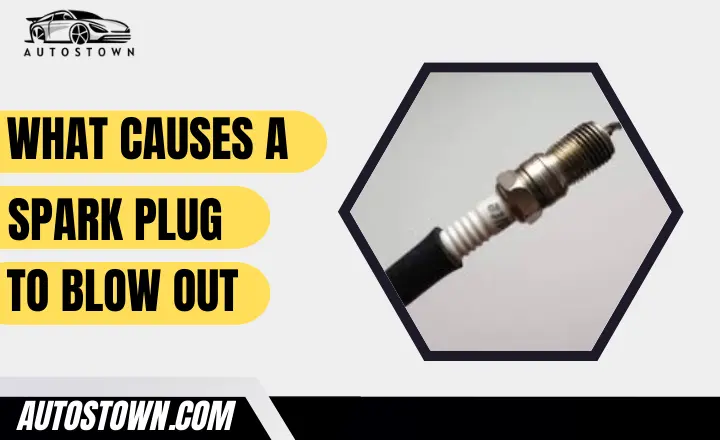Do you ever lose electricity after hearing a massive bang under the hood of your automobile? You’ve in all likelihood encountered the scary blowout of a spark plug. It resembles a miniature explosion currently taking region inside your engine, and if it isn’t fixed right now, it can have disastrous effects. But what exactly are the consequences of a spark plug blowing out? We will delve deeply into the field of car mechanics in this blog and have a look at the numerous factors that contribute to this complicated phenomenon.
Spark Plug Blowout Symptoms
1. Misfires: If an engine misfires, there might not be enough combustion taking place, which may lead to a spark plug rupture.
2. Power loss: If your car all at once feels slow and struggles to boost up, it may be due to the fact a blown-out spark plug has disrupted the combustion technique.
3. Rough idling: Your car can also exhibit unpredictable shaking and vibrations at idle speed while one or greater cylinders are impacted with the resource of a blown-out spark plug.
4. Lower gasoline efficiency: A defective spark plug can lessen mileage with the aid of causing an inappropriate air-gas combination.
5. Loud noises and backfires: An abrupt popping noise or a sporadic backfire through the exhaust could factor into ignition issues.
6. Difficulty beginning the engine: Poor sparks can weaken the ignition machine, making it tougher to start your car.
7. Engine overheating: Improper combustion introduced by spark plug displacement can position pressure on different engine elements, probably inflicting overheating troubles.
8. Higher emission degrees: Poor ignitions have a damaging effect on gas combustion, which results in higher emissions that can be measured during emission checks.
9. Strange smells or exhaust smell: It may be an illustration that the spark plug has blown out if you start smelling something bizarre, like burnt rubber or fuel.
What Causes A Spark Plug To Blow Out Of An Engine
There are several factors that can lead to a spark plug blowing out.
1: Improper installation or torque specifications
This often takes place whilst the spark plug isn’t always mounted well or while the wrong torque specifications are carried out.
The threads may be stripped or broken because of over-torquing, which allows you to make it less difficult for the spark plug to blow out. On the other aspect, insufficient torque can also result in issues as it causes unfastened plugs to probably turn out to be loose and fall out of place.
Related:- How To Remove A Stripped Spark Plug – 6 Steps
2: Over-tightening or cross-threading during installation
During setup, damage to the cylinder head threads may end result from over-tightening the spark plug or move-threading the spark plug. Pressure in the combustion chamber rises as a result of this harm weakening the bond between the spark plug and cylinder head. A spark plug that has been blown out is the quit result of this high pressure in the end forcing the spark plug out of its area.
Cross-threading reasons the threads to be out of alignment and over-tightening can strip or deform them, all of which raise the hazard of a blown spark plug.
3: Build-up of carbon deposits
The accumulation of carbon deposits is one frequent cause of a blown spark plug. These darkened particles may build up over time on the insulator and electrodes, interfering with the spark. As a result, misfires or rough idling may occur because the spark plug is unable to effectively ignite the air-fuel mixture. High levels of carbon deposits may be a sign that the oil is being consumed too much or that the engine is running rich.
4: Mechanical damage to the spark plug
When a spark plug is tightened too loosely or isn’t always placed correctly, it might turn out to be loose over the years due to engine vibrations. Combustion gas leaks from the cylinder as a give-up surrender end result, inflicting misfiring and compression loss. If the spark plugs are knocked or bumped within the course of everyday engine upkeep or present system preservation, they’ll preserve harm and lose their efficacy.
5: High engine temperatures
The combustion chamber may experience too much pressure if an engine runs too hot. The spark plug can become loose as a result of the increasing pressure and eventually blow out. In addition, pre-ignition or detonation brought on by overheating can result in the spark plug being ejected from the cylinder head or causing severe force to be applied to it.
Worn-out or incorrectly torqued spark plugs can also cause blowouts and high temperatures. Spark plug threads may deteriorate over time from repeated heating and cooling cycles, resulting in a loose fit.
How Would You Monitor A Blown-Out Spark Plug
1. Visual Inspection:
Visual inspection is the first and simplest method of keeping track of a blown spark plug. Open the hood of your automobile and examine each spark plug closely to see if it is firmly seated in its socket. A spark plug blowout is possible if there is any visible evidence of damage, such as cracks or loosened connections.
2. Performance Monitoring:
Paying attention to how your vehicle plays is another efficient method to stumble on a blown spark plug. Misfires or a notable drop in engine power also are telltale signs and symptoms of a blown spark plug. Watch your automobile’s acceleration, idle, and response to throttle inputs for any unusual behavior that can suggest a terrible spark plug.
3. Spark Plug Fouling:
You ought to keep a watch out for fouling on the ultimate plugs whilst checking for blown spark plugs. It may be a signal that some other spark plug has been blown out and is not firing well if one or more of them start to build up immoderate quantities of carbon deposits or get oil-fouled.
4. Strange Noise:
While this monitoring method may call for acute hearing, listening to odd noises while driving can offer important clues about whether you have a blown-out spark plug problem. Be aware of any popping or clicking sounds emanating from the engine compartment or from under the hood when the vehicle is idling; these could indicate issues with your ignition system brought on by a malfunctioning spark plug.
5. Diagnostic Equipment:
Diagnostic tools are one of the best ways to keep an eye on a blown spark plug. For your vehicle’s spark plugs, this contains a scanner or code reader that can find any problems. You may quickly find any spark plug problems and get error codes that signify a blown-out plug by attaching this equipment to your car’s OBD-II connection.
Conclusion
Several factors can cause a spark plug to blow out. The maximum frequent reason is incorrect setup or tightening, which can cause the plug to turn out to be unfastened and in the long run, blow out underneath pressure. Excessive cylinder pressure—which might be due to a broken engine or carbon buildup—is another aspect. Additionally, blowouts may be because of the use of the wrong spark plug or one that is too brief.
Spark plug blowouts can be prevented by way of recurring upkeep and using the right installation strategies. Both vehicle owners and mechanics should be privy to these elements and take the important precautions to save you this hassle. By doing this, people can also make certain that the ignition device in their automobile operates properly and lasts a long time.
FAQs
How much does it cost to repair a blown-out plug?
The solving rate can vary from 500 dollars to a thousand greenbacks relying on your can and the elements to address. It may even depend on the mechanic’s service rate, so the cost may even surpass or be lower than the limit we said.
Is it possible to drive even with a damaged spark plug?
In preferred, a vehicle can still run on a useless spark plug, but it’s miles hazardous to keep going with it. Once you locate any hassle with the engine, we advise you to have it repaired and now not overstress the engine with the aid of driving in this kind of damned state of affairs.
How to prevent engine blowout?
The exceptional manner to go about it is far to put in the spark plugs well. Follow the steerage advocated by means of your car manufacturer or permit a professional mechanic to deal with it. In terms of alternatives, always use well-matched plugs with matching sizes to healthy the cylinder head. Avoid pass-threading, which can cause blowouts.

